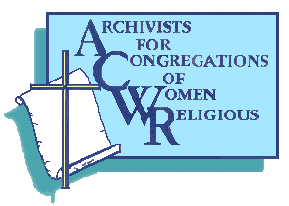 |
|
Practical Tips |















 |
| |
|
Enjoy these tips? Submit one
or two ideas ( about 250-300 words) to
S. Louise Grundish, SC at
lgrundish@scsh.org
and your great ideas will be added to the list.
|
|
˛ ˛ ˛ ˛ ˛ |
|
Tips for Enhancing Your Annals
The FSPA
archivist shared a memo she sent to her community: One part of
our social history that might be important to future historians is
our individual travel outside the U.S. No doubt we have each made
mention of trips in our Annals. Besides that, I would like to
compile a spreadsheet that would summarize each Sister’s travels.
Then, in the future, as I hear of someone’s trip, I will add that
to the spreadsheet.
Please list the
major trips you have taken outside this country. Include the year
and purpose. Include in your travel summary convention sites, family
visits, vacations, teaching abroad, etc. Ministry sites need not be
included since we have a record of those already. But travel to
Japan while you ministered in Guam, for example would be worth
noting. The memo included a place to list these.
Mary Ann
Gschwind, fspa
mgschwind@fspa.org
|
|
˛ ˛ ˛ ˛ ˛ |
|
Finding a “Certificate of Obedience,” a picture and winning ribbon
for Spike of St. Augustine (Spike, for short) the dog led to a
unique idea from the archives of the Sisters of the Living Word.
For the Feast of St. Francis of Assisi, the archivist wrote an article about the different pets the sisters have had throughout
the years! Woof!
Gwyneth Stupar
gstupar@slw.org |
|
˛ ˛ ˛ ˛ ˛ |
|
Two Tips for Saving Time in the
Archives
Save time
later: Why waste valuable time refoldering and labeling files
when they are transferred to the archives? Save time and energy for
yourself and make material available more efficiently by supplying
acid-free folders and foil-backed labels to your administrative
secretary. This way, from the time and point of origin, the records
are filed in the correct archival material. When the time comes to
transfer the administrative records to the archives, simply transfer
them directly to records center cartons or document cases; label the
container; shelve—little or no further processing is necessary.
Even better
(although this may be too much to ask or expect!) – have your
secretary prepare a list of all files labels- with a little shifting
to match box contents, you have the basis of a finding aid with
little or no work on your parts.
Quick
Reference Answers: We all know that there are some questions
that, like the Energizer Bunny, just keep coming and coming. Save
time looking up the same information by preparing a Ready-Reference
File where you keep the answers to those questions most frequently
asked. You can also note where the original information was found
so, if you have to return to the source, you know immediately where
to go.
Within the last
few years, I’ve developed a Reference Request Database. Each month
at the time I prepare my monthly reports, I enter the requests from
the month (written on a 4X6 notecard) into the database. The
headings on the request form are: general topic of the request; name
of person requesting; date of request; form of request, i.e.,
e-mail, letter, phone, etc; question, brief response and/or location
where answer was found; and referral if necessary to the original
reference request form for more detailed information. Often someone
needs something and I know that I’ve had similar requests in the
past- sometimes, years ago. Particularly in cases where the research
was more complicated and time-consuming, this database makes it much
easier to pull the correct records in a much more efficient and
timely fashion.
Mary
Serbacki,osf
Stella Niagara, NY
serbacki@intotem.net |
|
˛ ˛ ˛ ˛ ˛ |
|
Tips to Help Researchers
Don’t discard
your old National Catholic Directories!
When someone
requests information, particularly if searching for a religious or
member of the clergy- and not directly associated with your
Congregation, you may be able to assist them in their search by
looking at the National Catholic Directory for the particular
diocese to locate the Congregation or parish. Once the Congregation
is known, often you can look it up and provide a website to the
researcher so he/she can make the contact.
S. Marylu
Stueber, FSM
mstueber@fsmonline.org |
|
˛ ˛ ˛ ˛ ˛ |
| |
Developing a Self-Guided Tour Booklet for a
Heritage Room
When
our motherhouse was renovated and Regina Health Center for independent,
assisted, and nursing care for religious communities, diocesan priests,
and laity was created, the Heritage Room and archives was relocated and
many more people began visiting. The Sisters of Charity of St. Augustine
came to Cleveland, OH in 1851, and were founders of early hospitals,
orphanages, social service agencies in the area and there are items from
all these institutions as well in the Heritage Room (42’ X 16’). Not
having time to conduct all these tours, I developed a 17 page (51/2 X
81/2) booklet which described the contents of the room, with some brief
historical background on the items. The labels on each artifact or case
or photograph match the description in the booklet so it is easy to
follow. Visitors are invited to take the booklet with them if they wish.
I revise the booklet every 2 years and an introductory note explains that
some things may have been added.
At the end of the booklet a sentence suggests other places in the building
or on the grounds that have historical significance. Although I do group
tours, I still give out the booklet so that those who want to wander
around can still get the information. Contact me if you would like a
copy - smdm@srsofcharity.org |
|
|
